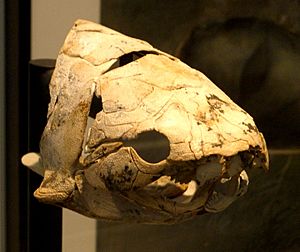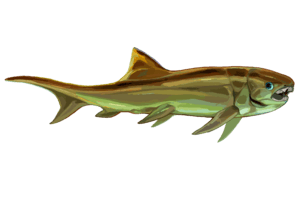Eastmanosteus facts for kids
Quick facts for kids EastmanosteusTemporal range: Middle to Late Devonian
|
|
|---|---|
 |
|
| E. calliaspis skull on display at the American Museum of Natural History in New York | |
 |
|
| Artist's reconstruction of E. calliaspis | |
| Scientific classification | |
| Kingdom: | |
| Phylum: | |
| Class: | |
| Order: | |
| Suborder: |
Dunkleosteoidea
|
| Family: |
Dunkleosteidae
|
| Genus: |
Eastmanosteus
Obruchev, 1964
|
| Type species | |
| Dinichthys pustulosus Eastman 1897
|
|
| Species | |
|
|
Eastmanosteus (which means "Eastman's bone") was a type of ancient, armored fish that lived a very long time ago. These fish were part of a group called placoderms, known for having strong, bony plates covering their heads and the front part of their bodies. Eastmanosteus was a close relative of the much larger and more famous Dunkleosteus.
Even though they were related, Eastmanosteus was different from Dunkleosteus in a few ways. They were generally smaller, and their bony armor had a unique bumpy pattern. They also had slightly different skull shapes. Eastmanosteus had very powerful jaws with sharp edges, which tells us they were likely active hunters, preying on other animals in the ancient seas.
Fossils of Eastmanosteus have been discovered in many parts of the world. These fossils are found in rocks that formed from marine sediments during the Middle to Late Devonian Period. These ancient fish were medium to large in size. Some species, like E. pustulosus and E. licharevi, could grow up to 3 meters (about 10 feet) long!
Contents
Amazing Discoveries About Eastmanosteus
Scientists have learned a lot about Eastmanosteus from its fossils. One of the most amazing discoveries comes from Australia.
Eastmanosteus calliaspis
This species was found in the Gogo Formation in northwestern Western Australia. Many complete skulls and body armor pieces have been found here. What's really special about these fossils is that they show traces of soft tissues. Scientists have found evidence of muscle fibers, blood vessels, and even nerve tissue! This is incredibly rare for such old fossils and helps us understand how these ancient fish moved and lived.
The largest skull of E. calliaspis found is about 27 centimeters (10.7 inches) long. This suggests the whole fish was roughly 1.5 meters (about 5 feet) long. E. calliaspis was one of the biggest fish living in the Gogo area at that time. Some scientists even think E. calliaspis might be different enough from other Eastmanosteus species to belong in its own genus!
Other Interesting Species
- E. licharevi: This species is from Russia. It was first described from a single neck plate fossil.
- E. lundarensis: Found in Canada, this is one of the earliest and most complete Eastmanosteus species known.
- E. magnificus: This species is known from a nearly complete head shield found in New York State, USA.
- E. pustulosus: This is the "type species" for Eastmanosteus, meaning it's the main species used to define the genus. It was a large fish found in many places, including the USA and Poland.
- E. yunnanensis: This species was discovered in China.
Images for kids


